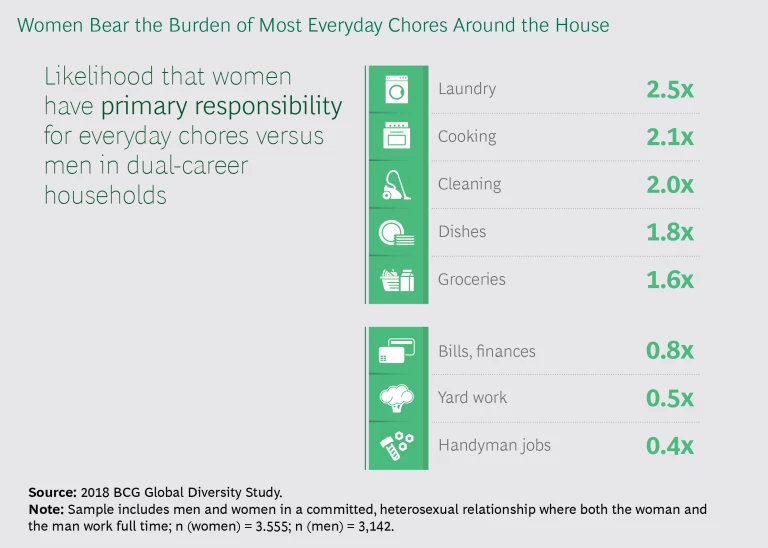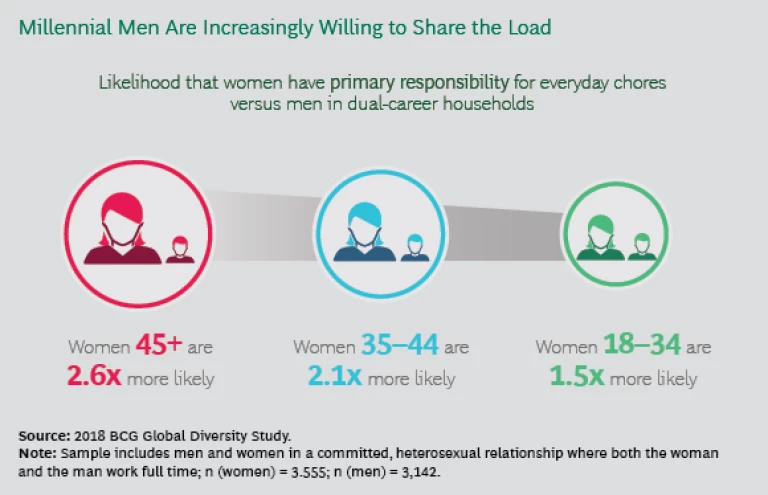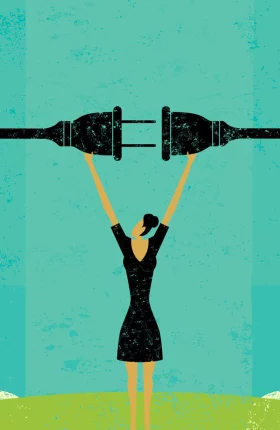In 2017, a comic by a French computer science engineer went viral. Called “The Mental Load: A Feminist Comic,” it deftly illustrated the concept of the mental load, which is familiar to women but sometimes difficult to describe. In the opening anecdote, an overwhelmed mother, trying to juggle cooking a meal and feeding her kids, finally explodes at her husband, who shoots back, “You should have asked! I would have helped.” The cartoonist explained the problem this way: “When a man expects his partner to ask him to do things, he’s viewing her as the manager of household chores. The problem is that planning and organizing things is already a full-time job. When we ask women to take on this task of organization and at the same time to execute a large portion, in the end it represents 75% of the work.”
If you ask working women with families why they step off the leadership track, it’s often not just because of what happens at the office. Rather, it’s because of the combined effect of their daytime job together with their second job of managing the incessant responsibilities of household and family care: what needs to be done, who needs to be where, how to make it all happen at once. This home management load is constant, underrecognized, unpaid—and it falls disproportionately on women, limiting their ability to focus on their careers and rise into leadership roles.
The home management load is constant, underrecognized, unpaid—and it falls disproportionately on women.
In response, some companies may argue that what happens in employees’ homes is not their concern. Given the way that work and home lives are intertwined, however, that mindset is both shortsighted and outdated. If companies are serious about getting more women into the ranks of leadership, they need to address the burden of domestic responsibility and its contribution to the mental load that women carry. Our research points to specific steps that companies and individuals—both men and women—can take.
The Burden That Women Carry
To quantify the load that working women carry at home, BCG recently surveyed more than 6,500 employees in 14 countries across industries, seeking input into who bears responsibility for common household tasks, including grocery shopping, cooking, cleaning, paying bills, and yard work. And because we wanted to look specifically at the dynamic between men and women in working families (even though nontraditional family structures are increasingly common and our sample would represent only a portion of working population), participants were required to be in a committed, heterosexual
Perhaps unsurprisingly, we found that the distribution of time-intensive household chores remains heavily skewed along traditional gender lines, even in households where both spouses work full time. Women are more likely to handle tasks that are time sensitive and occur frequently. For example, someone needs to leave work on time every day to ensure that dinner is on the table and the family is fed; similarly, someone needs to clean up afterwards. This is the daily grind, and women tend to shoulder the primary responsibility for it.
While many men are taking on more tasks at home, the average man in a dual-career household still does not share responsibility equally with his partner. These men get more time to focus on their careers—to stay late at the office, meet colleagues for drinks or dinner after work, take on stretch assignments, or travel for business—and more time to decompress from the workday. When the average man does help around the house, he tends to take on more of the less frequent tasks, which are not as time sensitive and more easily outsourced, such as finances and yard work. (See the exhibit.)
When the average man does help around the house, he tends to take on tasks that are less time sensitive and more easily outsourced.
Approximately one-third of people in dual- career households say that they share responsibility equally for everyday household chores, such as cooking, cleaning, laundry, and doing dishes. However, women are still 1.9 times more likely than men, on average, to have primary responsibility for these chores. The same dynamic holds true even in situations where a woman works full time but her spouse works part time or not at all. In those cases, the woman is only 4% less likely to be primarily responsible for everyday chores than a woman in a household in which both people work full time.
In other words, while most men do perform household chores to some degree, the mental load—the task of orchestration and project management—still falls disproportionately on women. For example, even if a husband takes a child to a doctor’s appointment, the wife usually will have been the one to research doctors, book the appointment, tell the spouse where to go, print out the school health forms, and track down the vaccination record. One bright spot is emerging, however: among millennials, couples are more balanced about handling domestic chores. (See “Younger Men Want to Step Up.”)
Younger Men Want to Step Up
Younger Men Want to Step Up
One encouraging aspect of our findings is that demographic trends and evolving attitudes are working in women’s favor. The physical and mental loads of everyday household chores fall much more heavily on older women than on millennial women. Women ages 45 and older are 2.6 times more likely than men in the same age group to carry the load of domestic chores. Women ages 18 to 34, however, are just 1.5 times more likely to do so than men in the same age group. (See the exhibit below.) That’s not equality—yet—but it is real progress.
This finding tracks with other BCG research showing that millennial men are more likely than older men to be part of a dual-income household. They are also more likely to contribute to childcare and to adapt their behavior at work in support of their female coworkers. (See “How Millennial Men Can Help Break the Glass Ceiling,” BCG article, November 2017.)
The increased mental load on women has real consequences for most companies, primarily in the form of impeding the movement of talent through the pipeline. Notably, our previous research has shown that, despite conventional wisdom, neither getting married nor having children makes women less ambitious than men. Instead, ambition levels are far more influenced by corporate culture. (See “Dispelling the Myths of the Gender ‘Ambition Gap’,” BCG article, April 2017.) Women still want to reach the top; it’s just much harder to do when they’re juggling so many different tasks at home. But organizations that help women manage the load—and offer the right kind of support—can ensure that they are allowing people to reach their full potential.
Solutions for Women, Men, and Companies
This is a complex problem, and it requires a multifaceted approach. Companies and individuals—both women and men—can do several things to lighten the mental load.
Recommendations for Companies
Internally, companies can offer flexible work arrangements, celebrate role models, and increase the support for working parents (regardless of gender). Externally, some companies can create significant social impact by changing the way women are portrayed in consumer advertising.
Offer flexible work arrangements. Flexibility—for both men and women—can help dual-career couples balance the load, especially given that younger men are increasingly willing to take on household tasks. Companies should allow employees to work under flexible terms as long as the work gets done, rewarding results rather than face time in the office. This includes formal programs, such as remote work or a shift in working hours, as well as informal practices, including the ability to take in stride the occasional situations that inevitably arise, such as leaving early for a child’s concert or doctor’s appointment.
Flexibility—for both men and women—can help dual-career couples balance the load.
Technology can help. Tools such as videoconferencing, virtual collaboration devices, telehealth services (for parents with sick children), and online networks for employees to share advice about common struggles can reinforce flexible work and provide a support system for dual-career households.
Celebrate role models and dual-career couples. Leaders—male leaders in particular—need to serve as role models by actively taking advantage of flexible work programs and sharing stories about how they balance the mental load at home. For men, this can help remove the stigma of greater participation in domestic and childcare duties.
Paternity leave is a great example. Many companies have a policy in place for new fathers, but those who take advantage of it are often stigmatized. This should not be the case. Apart from providing valuable bonding time with a new baby, paternity leave also allows husbands to experience what their wives do at home and to see firsthand just how much work goes into running a household and a family. The analytics firm Humanyze has gone even further: it mandates paternity leave for new fathers in order to destigmatize the practice and ensure that men take advantage of the time off.
Increase the support for all working parents. One way to offer more support to employees is to create a parents’ network for both fathers and mothers. In North America, BCG recently launched the BCG Families Network, which was expanded from an earlier Working Mothers’ Network and now includes all caregivers (such as people helping with elderly parents). The program has been made available in the firm’s offices to allow more targeted and relevant support. It offers childcare and caregiver support via panel discussions, information, and other resources; one-to-one connections and buddy programs; family activities and events; and help with understanding the full suite of resources that BCG provides.
Companies can also offer structural support, such as onsite day care, backup childcare with locations near work, babysitting referral services, eldercare support, financial planners, and wellness providers. Some HR departments now provide online resources that vet and list popular outsourcing options—housecleaning, laundry services, grocery delivery, and personal assistants—and even negotiate discounted corporate rates.
Change consumers’ thinking about how couples can balance the load. Many commercials still perpetuate outdated gender roles, but a few companies are working to change that, and some global inititiatives aim to remove stereotypes from commercials entirely. For example, the United Nations launched the Unstereotype Alliance to eradicate all harmful gender-based stereotypes from advertising, including ones where women do all the housework. The project includes Adobe, AT&T, BCG, GlaxoSmithKline, Google, IPG, and Unilever.
What’s more, the issue isn’t only a moral one, it’s also economic: a 2018 Ipsos study for the Unstereotype Alliance found that 72% of consumers feel that most advertising doesn’t reflect the world around them, and more than 50% really take notice when advertisements depict men or women in traditional or old-fashioned roles. And research by Unilever has shown that ads free from stereotypes are 25% more effective and deliver better impact for the brands depicted than conventional ads.
In India, for example, Procter & Gamble launched an ad campaign called “Share the Load” for its laundry detergent brand Ariel Matic, encouraging dads to help with laundry. The ads went viral and generated a 42% increase in brand awareness, along with $12.3 million in earned media coverage and conversations on social media. Similarly, Indesit, an Italian appliance manufacturer, launched a “Do It Together” campaign in 2017, encouraging men to help with household chores. It garnered more than 30 million views in its first three weeks.
Recommendations for Men and Women
We at BCG may not be experts in marital relationships, but we are experts in improving performance in the workplace. And we think that many of the principles that lead to success at work, such as the following, also have the potential to help couples manage the mental load together.
Quantify the problem and communicate openly. As our research shows, men are helping out with household and family chores, just not at equal levels in most dual-career households—particularly when it comes to coordination and balancing the mental load. Often, this is a result of asymmetric information. Many men who don’t actually see household tasks being done don’t fully understand the amount of time and effort that go into them, particularly during the planning stage. Even many women would not be able to tell you exactly how much time they spend on household responsibilities; they just know that it’s a lot. And yet, in the business world, we often say that what gets measured gets changed. So track the actual time spent on specific tasks—including planning—and talk about it.
Clarify roles and find the comparative advantage. With a clearer joint understanding of how much each person contributes to managing and executing tasks, couples can have a detailed discussion about how to share the load and shift responsibility where appropriate. This should not be about men “helping’” or women “delegating.” The discussion should include how to share the full responsibility for tasks at home—both the planning and the coordination of tasks as well as their execution. At the same time, women need to completely step away from the tasks that they have shifted to their partner, which may involve reducing their expectations for exactly how things get done, especially at first.
Couples should have a detailed discussion about how to share the load and shift responsibility where appropriate.
From an economic perspective, it’s not about absolute advantage (who does the task best) but about comparative advantage (what’s the most efficient way to share the work). Given the opportunity cost of your time and the value of investing in career and family, you may want to find comparative advantage by outsourcing low-value tasks when possible and affordable.
Prioritize. Women typically feel more pressure than men to be an involved parent. Through years and years of social conditioning, women have been taught that their primary role in society is that of the caregiver, and that career and self are secondary. Conversely, men have been socially conditioned to view their role as one of provider and breadwinner. As those concepts evolve, part of the solution for women comes from prioritizing what matters most to them at work—and at home—and cutting out everything else, regardless of societal expectations. Achieving perfection might seem impossible, but you can get closer.
Lifting the mental load entirely may not be easy, but the measures discussed here will help ease it and smooth the path for more women and men to achieve successful, fulfilling careers alongside their home lives—and to achieve successful, fulfilling home lives alongside their careers.








